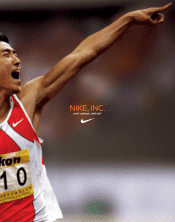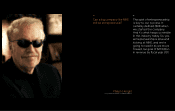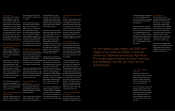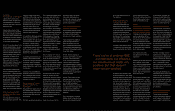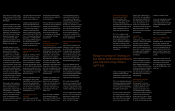Nike 2007 Annual Report Download - page 8
Download and view the complete annual report
Please find page 8 of the 2007 Nike annual report below. You can navigate through the pages in the report by either clicking on the pages listed below, or by using the keyword search tool below to find specific information within the annual report.
ON GROWTH . . .
How much more can NIKE grow?
I don’t believe in limits, but I
believe in goals. Our goal is to
reach $23 billion in revenue by
scal year 2011, and I’d say we’re
well on our way.
Seventy-ve percent of that
growth will come from the NIKE
brand. The strength of the NIKE
brand is our most valuable asset.
It’s intangible, it doesn’t show up
on the balance sheet, but really
it’s our most valuable asset.
We see tremendous opportunity
in both established and emerg-
ing markets around the world.
In the U.S. revenues grew seven
percent in scal 07. NIKE is the
fastest growing running brand
in Germany. In Russia we’ve
doubled revenue in the last
three years. We’re the No. 1
athletic brand in China, a market
we expect to be our second
largest within three years.
Our promise is to deliver con-
sistent, protable growth over
the long term — high single-digit
revenue growth and mid-teens
EPS. Since we introduced this
growth model in 2001, we’ve
generated a revenue CAGR of
nine percent, grown EPS at 18
percent, and seen ROIC grow
from 14 to 22 percent. In other
words, we’re keeping our promise.
What strengths do the NIKE
subsidiaries contribute to your
growth plan?
Our subsidiaries are critical to
NIKE reaching its potential. They
represent a more diversied
portfolio, and they help keep the
NIKE brand focused, allowing
us to develop new business op-
portunities where we don’t want
the NIKE brand to go. There is
also a lot of opportunity for
complementary growth across
the portfolio through sharing
resources and efciencies.
In scal 07 the NIKE subsidiaries
grew revenue 16 percent to
reach $2.3 billion. We saw record
revenues and PTI for Converse
and Hurley, record revenue
for Cole Haan, and record PTI
for NIKE Bauer Hockey. Over the
last ve years, the subsidiary
brands have more than doubled
their revenue contribution.
To see the potential of the sub-
sidiaries, you just have to look
at Converse. Revenue increased
23 percent, and PTI increased
133 percent. In fact, Q4 was the
biggest global sales quarter ever
for Converse.
And next year is the 100th an-
niversary of Converse, so we’re
busy cooking up some special
concepts to celebrate the cen-
tennial of the brand.
How do you convert revenue
growth into value for your
shareholders?
For growth to be good, it has to
be protable and sustainable.
There are two big levers we pull
to drive health and value into
the business.
The rst is operational excellence.
This is really about maximizing
our supply chain efciencies
and minimizing costs. Since
2001 we’ve had nine successful
supply chain implementations.
That helps us better manage
forecasting and inventory.
There’s a lot we do to manage
product costs — lean manufac-
turing, raw materials consolidation,
making sure we optimize our
SKU management, focusing
on the most protable styles.
We’re also ramping up our
digital samples and 3-D model-
ing to reduce costs in product
development. There is a
lot of discipline around the
company on becoming leaner
and stronger.
The second big lever we pull
to create value is cash deploy-
ment. We target a dividend
payout between 20 and 30
percent of our trailing 12-month
EPS. Since 2003, we’ve raised
our dividend payout from 20
to 24 percent. I’m proud of our
performance there.
We also return cash to share-
holders in the form of share
repurchases. We’ve increased
our share repurchases in each
of the last three years and have
nished our last two programs
well ahead of schedule. We are
currently buying shares under a
$3 billion, four-year, repurchase
program approved in June 2006,
and we’re well on our way to
completing that program on or
ahead of schedule.
I look at every part of the
business as part of an optimi-
zation plan, making sure we
leverage our resources, manage
our costs, and invest wisely in
growth opportunities.
What role will acquisitions play
in the NIKE growth plan?
We are always looking for ways
to expand our growth potential,
but within certain principles.
We ask a lot of tough questions.
“Does it improve our ability to
grow existing businesses?”
When the answer is yes, we
buy a company like Impact Golf
Technologies, which allowed us
to become the leading innovator
in golf club design.
We ask, “Does it expand our
consumer base within our culture
of sports?” When the answer
is yes, we buy a company like
Converse, which is delivering
tremendous growth by evolving
franchise concepts like the Chuck
Taylor, and by creating new ideas
in footwear and apparel that
resonate with young consumers
all over the world.
We ask, “Does it give us entry
into new consumer cultures
that can benet from the cross-
over of NIKE technology?”
When the answer is yes, we buy
a company like Cole Haan, which
uses NIKE Air to redene the
concept of comfort in fashion
footwear.
This is the benet of a strong
balance sheet, being able to ag-
gressively investigate and act
on the best opportunities for
the company.
What should shareholders
understand about NIKE?
I think as a shareholder you
should look at NIKE and ask
yourself, Are they really focused
on the right things? Is the product
innovative and compelling?
Is the consumer experience rich
and relevant? Are we being a
responsible corporate citizen
in the world? Are we completely
focused on the consumer?
And that’s really what our job is
— to make sure that we’re clear
about our potential. Kind of like
an athlete. We’re actually made
up of a lot of athletes, and I think
that permeates our culture. NIKE
has tremendous resources, but
we have even more opportuni-
ties. So we have to make sure
we are making the most of both.
And that requires a superior
management team, which we
have. We have the best team
in the business. Every leader at
NIKE brings a unique point of
view to the table. Consensus
is important, but not nearly as
powerful as ideas and debate.
And we have a lot of both.
There’s just a deep competitive
re that makes us try to be a
leader in everything we do.
ON NIKE . . .
NIKE’s mission statement is to
bring inspiration and innovation
to every athlete in the world.
What does that mean to you?
I think sports is a healthy and
positive expression of our
human nature. We’re competi-
tive, we’re physical, we’re
drawn to challenges. We like
to achieve things on a personal
level, and we like being part
of teams that share a passion
and a common goal.
To me sports, at its best,
is a noble part of the human
experience.
NIKE is a part of that experience.
We’re athletes, so we under-
stand sports and what athletes
need to compete. We’re inno-
vators, so we’re able to create
products that enhance perfor-
mance. And we’re passionate
about what we do.
There’s also an asterisk in our
mission statement — “If you
have a body, you’re an athlete.”
That’s actually a quote from Bill
Bowerman. He was the legend-
ary track coach at University
of Oregon, and co-founder of
the company. That asterisk
means a lot at NIKE. It speaks
to the removal of barriers, the
refusal to accept the limitations
of others, the right for every-
body to play and to compete.
So our mission is to take the
things we do best and share
them with the world and, hope-
fully, inspire and enable individ-
uals to reach their potential.
What makes NIKE different?
I think there are a few things I
see everyday that really set us
apart. First, we’re innovators by
nature. We’re xated, obsessed
by innovation. I think that NIKE
represents a passion and an
insatiable appetite to go deeper
with an athlete within sports
and to take those insights and
translate those creatively into
innovative concepts and prod-
ucts and stories.
We have incredibly wide pe-
ripheral vision, the ability to see
and be inspired by things that
happen in sports, but also in lm
and music and digital technol-
ogy — everything in youth
culture around the world. We’re
incredibly curious, but we’re also
incredibly focused.
We continually challenge our-
selves to be better. There’s a lot
of pride at NIKE. We believe in
what we do. We are a youthful
and a premium brand. Our inten-
tions, our inuence, our results
are all really very positive.
But that doesn’t mean that we
are satised.
How do you keep a $16 billion
company fast and nimble?
To stay quick and nimble,
you have to organize against
specic opportunities and em-
power people to attack those
There’s a lot of pride at NIKE
... our intentions, our inuence,
our results are all really very
positive. But that doesn’t
mean we are satised.

